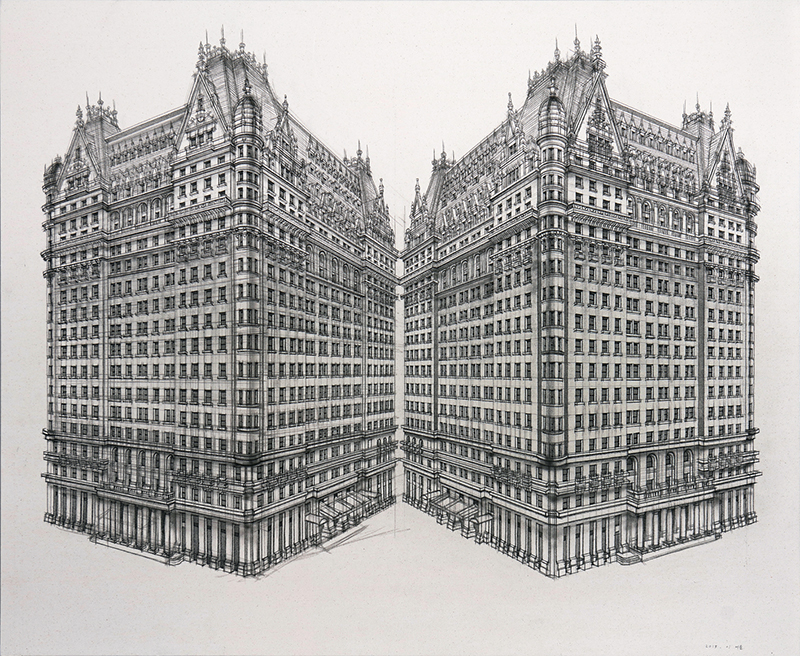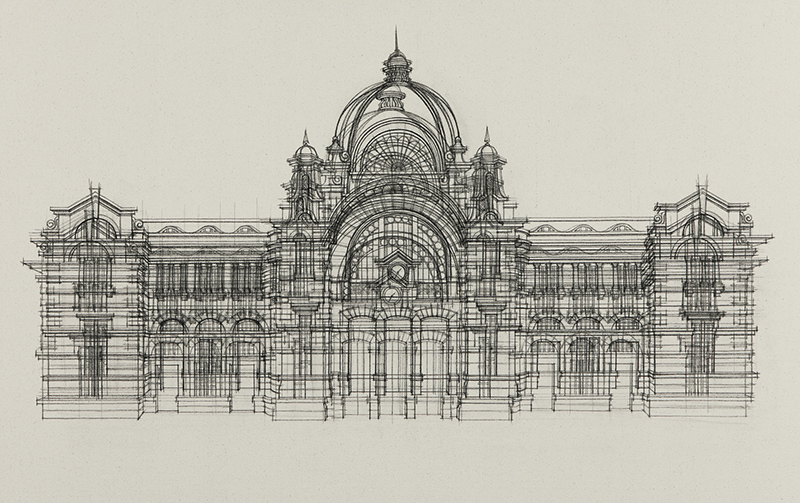Contemporary artist Yuwoon Lee centres her work around cities, embodying exteriors of cathedrals and temples alike, on a plane where space and narratives are ignored.
Understanding the environment that surrounded me became a way for me to understand myself today. Later on, understanding the structures of the city became a familiar approach enabling me to best understand the lives, culture, and ideals of that setting.

Artist portrait courtesy Yuwoon Lee.
Tell us a little about yourself and how your tryst with art begun. ?
I’m an artist who has done city-related work in Seoul, South Korea, for over 25 years. I’ve had a total of 25 solo exhibitions, every year since my first in 2002, to date. The media that I use are ink and the traditional fine brush of Oriental painting. I was nine years old when I truly began painting. As I went to different studios in the hopes of entering an art school known as ‘Yewon’, I began developing the dream of becoming a painter.
I majored in Oriental painting, and as recently as the time I was in school, all the Oriental painting departments at Korea’s art colleges were teaching landscape art, and all the students there were painting landscape art. The concept of mountain was quite difficult for me back then, and as someone who had been born and raised in the city, I found mountains very foreign as subject matter. So, I began painting the kinds of apartment complexes where I had grown up, rendering them from a bird’s-eye perspective. Understanding the environment that surrounded me became a way for me to understand myself today. Later on, understanding the structures of the city became a familiar approach enabling me to best understand the lives, culture, and ideals of that setting. Having been created over many years, the city’s structures speak to the history of the people who lived there.

Duplicate 2, Korean ink on canvas, 130 x 162 cm, 2017. Contemporary artist Yuwoon Lee.
For me, the city is a tool for understanding the forms of human existence and human beings themselves.
How would you describe your motivation and philosophy as an artist, in the context of challenging people’s perspectives via your work and art?
For me, the city is a tool for understanding the forms of human existence and human beings themselves. Early on, I painted cities as landscapes. But as time passed, I began removing the landscape elements and focusing purely on the structures. The reason I had eliminated the painterly elements was because I had begun questioning whether it was really necessary to have the elements of landscapes that had been forced on us in terms of two-dimensional representation, with things like perspective and composition. As I result, I’ve often been told how they resemble architectural floor plans or bird’s-eye images. But what I’m focusing on in these structures is the evidence left behind by people. Within structures, you find the moments left behind from the existence of finite beings, with all the thinking and experimenting and changing in human lives carried on through the architectural forms. Structures themselves are not infinite, but I see them as being like a kind of matrix harboring all the finite things associated with human beings, who appear for a brief moment and then are gone.

Detail view: Monument Gyeongbokgung. Korean ink on Canvas, 81 x 162 cm, 2017. Contemporary artist Yuwoon Lee.
What is the inspiration behind your work?
My ongoing interest in religious structures as monuments that are both familiar and strange, actually originates in my affection for old buildings. Religious buildings are comprehensive symbols encompassing the history and culture of a region and era; as monuments representing life and customs at the time, they are great spaces situated at the centre of the world. While they are familiar, mundane spaces that are constantly present deep within our lives, they are also unfamiliar settings that express a sense of awe and the divinity of an absolute being. Lines are endlessly layered to form the exteriors of cathedrals and other structures on a two-dimensional surface from which any sense of spatiality and narrative has been completely eschewed. Each thin line contributes to the layers that make up the single form. Just as a single structure forms over time through development and the creations of signs and symbols, shapes and forms, so time becomes layered and compressed on the stationary canvas as innumerable lines are drawn. Among these countless layered lines, the furrows of compressed time begin to appear.

Moment in Venezia 3, Korean ink on Canvas, 60 x 100 cm, 2017. Contemporary artist Yuwoon Lee.
I’ve maintained an ongoing attachment to old structures with my ink-and-wash.
How would you describe your style?
I’ve maintained an ongoing attachment to old structures with my ink-and-wash. You could say that I’m not painting the completed exteriors of structures so much as I’m painting the framework of the building’s basic structure. It may look like an architectural floor plan or diagram, but it’s actually based on me understanding the building’s structure, recombining it in my head, and expressing it in my own way. It looks like reality, but it isn’t reality – you could see it as a case where the boundary between the real and virtual collapses. When three-dimensional space is represented through two-dimensional materials, it creates a new space and time.

Monument Seoul station 4, Korean ink onCanvas, 97 x 145.5 cm, 2019. Contemporary artist Yuwoon Lee.
Tell us about the evolution of your practice over the years and your commitment to your current medium.
I work mainly by painting on canvas with an Oriental painting brush with ink. I also do work on hanji (traditional Korean paper), but these days I’ve been doing a lot of canvas work. The basic design of the painting is created chiefly through lines, and I tend to understand and represent the subject’s structure solely through lines, without expressing the shading or sense of mass.
Ink is a traditional medium that has been passed down over the generations in Korea, China, and Japan alike. It has its own unique properties as a material. When mixed with water, it spreads well, and delicate shading can be fully rendered through just one colour – black – while you can also produce a sense of thickness without spreading through the layering of thick concentrations of ink. Once it’s finished drying and the moisture evaporates, it hardens into something that remains permanent and indelible, even though it isn’t oil-based, and that makes it very handy for preservation. These aspects are well suited to my work, which relies mainly on lines.
Often, there are people who don’t really understand these aspects of Korean ink, and they will suggest that I use acrylic or charcoal. Those are completely different materials, and they can’t replace the advantages of ink.

Salon De Venise Open Studio ‘Moment in Venezia’. Contemporary artist Yuwoon Lee. Residency in Venice, Italy, 2017.
If there are different ways of approaching a certain truth, then my approach involves focusing on forms. They often say that “form makes content,” and it’s also the approach I’m most capable of employing.
How do you deal with the conceptual difficulty and uncertainty of creating work?
If there are different ways of approaching a certain truth, then my approach involves focusing on forms. They often say that “form makes content,” and it’s also the approach I’m most capable of employing.
I’m not really all that interested in things like directly expressing human feelings or telling lots of secondary stories or creating some kind of narrative structure. I like reading the forms of structures with my own eyes and interpreting and understanding them in my own ways. You can see it as being similar to finding the codes in the circuit diagram of an old machine whose manual has been lost.

Memory Architecture of DMZ Project / Mirage Labor Party Office, Korean ink on Canvas, 145 x 435 cm, 2019. Contemporary artist Yuwoon Lee.
Is there any topic lately, that you would like to be mentored on?
I planned the project as a way of exploring Korea’s unique environment as the world’s only remaining divided nation, as well as our remembrance and forgetting of the historical and cultural scenes in the DMZ (demilitarised zone) border region, which has been both a symbol of separation and a setting of exploitation. The project involves summoning up examples from my own experience within the context of division and specific places, types of places, and incidents and applying the logical forms of urban structures to actual experience in order to deduce the meaning of history that can be found in the physical scope of settings as you focus your attention on them.

Exhibition view: Modern Times Series at Gyeonggi Creation Center, 2019. Contemporary artist Yuwoon Lee.
Tell us about your studio and what your typical work day looks like in the studio?
My studio is located not far from my home. I’ve been painting since a very young age. At nine, I began going to studios after school, and I would spend my days with high school students who were preparing for their university entrance exams, painting until 10 at night before returning home. I’ve continued that sort of lifestyle to this day. In a way, it’s stranger for me not to be painting. It was tough for me to travel over an hour from my home to attend the studio every day when I was a child – but I feel tremendously fortunate to be able to live my life as I do today, regarding art itself as the value of life.

Daeungjeon of Jangansa, Koreanink on canvas, 89 x 145.5 cm, 2015. Contemporary artist Yuwoon Lee.
What are you currently working on?
I’m working on a New York theme. In July and August this year, I plan to stay in Residency, New Jersey, USA for two months. The result will be exhibited at Gallery Art Mora Space missing (www.artmora.com) in New Jersey in August.
For enquiries contact: leeyuwoon@gmail.com
Before you go – you might like to browse our Artist Interviews. Interviews of artists and outliers on how to be an artist. Contemporary artists on the source of their creative inspiration.











Add Comment